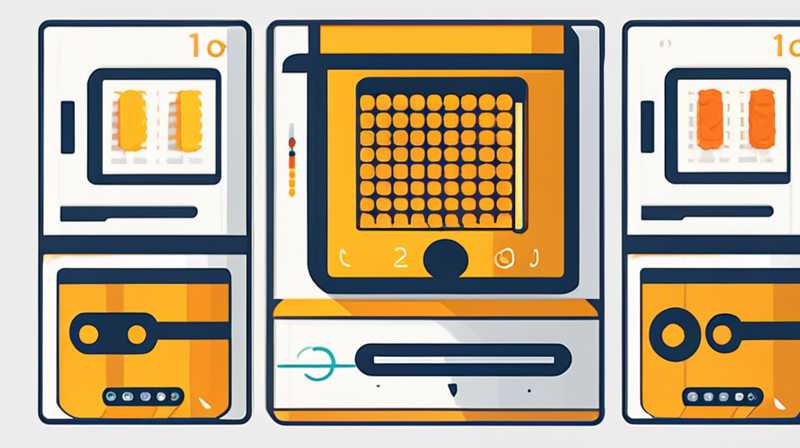
If the solar controller does not function, ensure you check various components and conditions to identify the problem. 1. Verify connections, 2. Inspect the power supply, 3. Reset the system, 4. Consider external factors. Each component of a solar energy system plays a vital role; issues with the controller might be symptomatic of deeper system faults. In detail, ensuring that all electrical connections are secure can prevent intermittent problems. Faulty wiring or loose terminals can lead to non-responsiveness, ultimately compromising the efficiency of the energy system.
1. INTRODUCTION TO SOLAR CONTROLLERS
Solar controllers, the critical intermediary between solar panels and batteries, manage electricity flow efficiently. They prevent battery overcharging and deep discharging, essential for prolonging battery life. As Australia continues to lead in solar energy adoption, understanding these devices becomes crucial for optimizing performance.
The term “controller” encompasses various types, including PWM (Pulse Width Modulation) and MPPT (Maximum Power Point Tracking). Each has specific functions; PWM typically suits smaller systems while MPPT maximizes power in more extensive setups. Understanding the distinctions between these controllers aids users in selecting the right options for their solar installations.
2. COMMON SYMPTOMS OF A MALFUNCTIONING CONTROLLER
Identifying the symptoms is crucial for timely intervention. A solar controller’s failure can manifest through various visible signs, including flickering display screens, unexpected battery drainage, and failure to recharge batteries. Each of these indications serves as a diagnostic tool for users, pointing towards potential underlying issues.
Another common symptom is overheating. Inadequate heat dissipation can cause internal components to fail, leading to a controller operating suboptimally. Monitoring temperatures and ensuring that your solar controller has proper ventilation can significantly impact longevity and performance.
3. ANALYZING POTENTIAL CAUSES OF FAILURE
Understanding the causes of controller malfunctions fosters informed troubleshooting. One significant factor includes electrical connections. Faulty wiring, corroded terminals, or loose connections can lead to erratic behavior. Regular inspection and maintenance of these connections can ensure the reliability of the entire solar energy system.
Moreover, environmental influences can also contribute to a controller not functioning correctly. Harsh weather conditions, such as prolonged exposure to high humidity or extreme temperatures, can damage materials. Thus, safeguarding the solar controller from direct exposure is vital.
4. TROUBLESHOOTING STEPS TO FOLLOW
When the solar controller exhibits issues, troubleshooting is imperative. Start with verifying electrical connections. Ensure that all wires and terminals are secured firmly; corroded connections can cause fluctuations in power supply. Clean any visible rust or corrosion and replace damaged connectors to restore functionality.
Next, inspect the power supply. Check for consistent voltage input from the solar panels. Use a multimeter to measure voltage and ensure levels are within the recommended range. A weak or irregular power source can lead to controller malfunctions, making this step essential for reliable performance.
5. RESETTING THE SOLAR CONTROLLER
Resetting the controller can resolve many minor issues. Most controllers feature a reset button, which, when pressed, reinitializes the internal processor. This action can clear minor errors and restore regular functions. In some cases, disconnecting the power supply temporarily can also achieve a reset.
However, it is essential to note that resetting does not fix underlying hardware issues. If the controller fails to reset properly or continues to exhibit abnormal behavior, further investigation is warranted.
6. CONSIDERING OTHER COMPONENTS IN THE SYSTEM
Failures in integral components can also impact the performance of the solar controller. Batteries, for example, play a substantial role; a faulty battery can mimic signs of a controller malfunction. Therefore, checking the battery’s voltage and state of health is crucial.
Additionally, inspect solar panels for obstructions. Dirt, debris, or shading can inhibit power generation, leading to inadequate energy for the controller to function correctly. Regular cleaning and maintenance of both the panels and batteries ensure optimal system performance.
7. WHEN TO SEEK PROFESSIONAL HELP
If troubleshooting efforts do not yield results, professional assistance may be needed. Qualified technicians possess the expertise to diagnose complex issues and recommend appropriate solutions. They can assess the entire solar energy system, identifying faults in the controller or other components effectively.
Sometimes, failing to address problems in a timely manner can exacerbate issues, leading to more significant expenses. Regular maintenance by professionals will also help identify small issues before they escalate into major failures.
FREQUENTLY ASKED QUESTIONS
WHAT OCCURS IF MY SOLAR CONTROLLER IS NOT WORKING PROPERLY?
If a solar controller malfunctions, the system could underperform, leading to battery overcharging or depletion. This scenario can result in damaged batteries and a waste of generated solar energy. Regular maintenance checks and addressing minor issues immediately can prevent significant troubles.
IS IT POSSIBLE TO REPAIR A MALFUNCTIONING SOLAR CONTROLLER?
In many instances, a failing controller can be repaired by professionals. The ability to fix the device depends on the nature of the problem, such as minor frays in wiring or improperly functioning software. Consulting an expert provides insights into whether repairs or replacements are appropriate.
HOW CAN I PREVENT MY SOLAR CONTROLLER FROM FAILING?
Regular maintenance is crucial for extending a controller’s life. Periodically inspect electrical connections, keep the controller ventilated, and monitor environmental conditions. Proactive measures, such as timely cleaning of solar panels, contribute significantly to preventing controllers from significant issues.
FINAL THOUGHTS
Managing a solar energy system requires diligence and understanding of its components. Identifying problems with a solar controller is vital for maintaining efficiency and prolonging equipment life. Regular inspections, thorough troubleshooting, and an awareness of environmental variables contribute to system health. Engaging professionals for comprehensive analysis when necessary can prevent simple problems from escalating. By implementing these strategies, solar energy users can ensure that their systems perform optimally, allowing for sustainable energy use for years to come. Prioritizing care and maintenance will not only benefit users practically but will also enhance the overall investment in renewable energy sources.
Original article by NenPower, If reposted, please credit the source: https://nenpower.com/blog/what-to-do-if-the-solar-controller-does-not-work/


